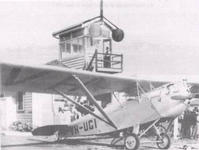


Recollections of Service in the Bureau and RAAF
Foreword
Recollections—Mascot and Rose Bay—the Early Years
Sojourn in the Far East 1942
References
Endnotes
Index
Search
Help
Contact us

When recreation leave was taken, Arthur White and I were relieved in turn, on one occasion at least by Mr (later Dr) P. Squires, who had also been on No 1 Meteorologist Course. Pat Squires did not like shiftwork at all; he was no practitioner, but it soon became evident he was an effective research scientist, spending his career in the Radiophysics Division of CSIRO and then in the USA National Center for Atmospheric Research (NCAR) in Colorado USA, where he died in 1990.
The met/radio hut stood a short distance in front of the Royal Aero Club building and on the edge of the aerodrome. About the only other buildings at Mascot were the large Australian National Airways (ANA) hangar and the Qantas hangar and depot round to the left and the right of the aero club respectively (looking south), the aero club hangar, the hangar and out buildings of the Kingsford-Smith Air Service and the small wooden control tower standing about 80 to 100 metres to the right of the met/radio hut. At that time of course there was no hard standing or tarmac on the runway(s), that whole area being grassed.


Before there were Observers, Arthur White and I covered the work between us in two shifts, solo on Sundays and part solo on the other six days, at first from 0600 to 1700 hours. Later, in 1939 when 0300 and 2100 observations commenced in the Bureau the shifts were extended. In any case, on the mornings when the Dutch service, KNILM took off early on its flight to Batavia via Archerfield and other places, it was necessary for us to conduct a 0200/0300 pilot balloon ascent and exchange it with Archerfield.
On these shifts, at first we did everything, mainly solo,—surface observations and pilot balloon ascents, despatching these by telephone to the GPO after encoding them; collecting reports from the GPO by telephone, decoding and plotting these with strict adherence to the station model; analysis of charts; forecasting.
At about this time we were supplied with a teleprinter and this meant a great improvement in the process of data reception. At this time there was a mixture of the Australian word code and the new 5-figure international code, the latter being used firstly by Bureau stations. As one would say these days, a teleprinter represented a significant technological advance.
People in Bright Sparcs - Hannay, Alexander Keith (Keith); Squires, Patrick; White, Arthur Charles
 |
Bureau of Meteorology |  |
© Online Edition Australian Science and Technology Heritage Centre and Bureau of Meteorology 2001
Published by Australian Science and Technology Heritage Centre, using the Web Academic Resource Publisher
http://www.austehc.unimelb.edu.au/fam/0344.html